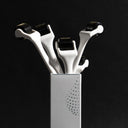Derma rolling has become a popular at-home technique to help stimulate collagen production and cell turnover. By creating micro-injuries in the skin with tiny rolling needles, it aims to trigger the wound healing process. While research shows it can provide benefits like reduced scarring and fine lines, there are also some potential disadvantages to be aware of.
What are the disadvantages of a derma roller?
Some key disadvantages of derma rolling include:
Risk of infection:
Creating tiny puncture wounds opens the skin up to potential infections, especially if proper hygiene isn't followed. It's important to sterilize the roller before and after each use.
Pain and discomfort:
Derma rolling, especially with larger needle sizes, can cause stinging or soreness that lasts for a few hours or days. This may discourage some from continuing regular use.
Scarring:
While unlikely with smaller needles, using too large of a needle size or applying too much pressure could potentially lead to scarring in rare cases of sensitive skin.
Injury to eyes:
There is a risk of accidental needle-puncture injury to the eyes if the derma roller slips or isn't handled carefully around the eye area.
Uneven results:
It can take practice and a steady hand to ensure the entire treatment area is evenly rolled. Missing spots may affect the overall outcome.
Expense:
While cheaper initially than laser or professional treatments, frequent derma rolling requires ongoing purchases of new sterile needle cartridges every few uses.
No instant effect:
As with any natural skin needling method, results from derma rolling take time - usually 4-8 weeks to see minor improvements and 3-6 months for fuller effects.
As your leading source for hair health information over the past 4 years, we never compromise on accuracy. When it comes to your health, you deserve information you can truly rely on - and earning your trust is our top priority.
Here's how Scandinavian Biolabs ensures every piece of content meets the highest standards of accuracy and integrity:
- Credentialed Experts: Our reviewers are actively practicing doctors and medical researchers
- Stringent Reviews: Content undergoes rigorous editing by subject specialists and review by a practicing doctor.
- Evidence-Based: We rely on well-established research from trusted scientific sources like peer-reviewed journals and health authorities.
- Full Transparency: Our editorial standards, writer credentials, reviewer credentials, correction process, and funding are all publicly documented.
- Independent Voice: While we do promote products, we operate in a vacuum to business operations. Our main goal is just an unwavering commitment to providing medically-sound guidance.
You can count on Scandinavian Biolabs to consistently deliver the trustworthy health information you deserve. Read our Editorial Standards.
Minimizing disadvantages:
To reduce risks, it's important to:
- Use the smallest needle size (0.25-1mm) recommended for the treatment area.
- Cleanse skin thoroughly before and after use and sanitize the roller.
- Roll with light, even pressure and avoid overly irritating the skin.
- Stop immediately if pain or irritation occurs.
- Apply a hydrating serum or cream after to aid healing.
- Replace needle cartridges regularly as recommended.
With proper precautions, derma rolling can provide skin benefits for many. But its disadvantages require cautious, sterile use to minimize risks versus other professional treatments.
Tired of thinning hair holding you back? Fight back with the medical-grade Scandinavian Biolabs Scalp Activation Derma Roller.
This isn't just any derma roller - it's packed with 540 medical-grade titanium needles designed to awaken dormant hair follicles and trigger thicker, healthier hair growth.
Imagine: a fuller head of hair you can be confident about.
And the best part? It's easy to use. Just roll it gently over your scalp once a week, even on wet hair. It's painless and works with your existing routine.
Don't waste another day with lifeless hair. Invest in your confidence with the Scalp Activation Derma Roller. Get yours today and watch your hair transform!

Read more:






